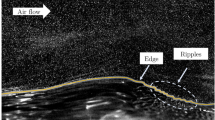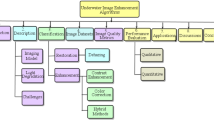Abstract
An objective wavelet based algorithm has been developed to find the orientation of rolls in Synthetic Aperture Radar (SAR) imagery using Radar Imaging Satellite (RISAT-1) data. The orientation of rolls plays a very crucial role for the estimation of ocean surface wind direction. It also affects the shape and size of a tropical cyclone. In this manuscript, SAR image was decomposed using Haar Wavelet Transform (HWT) and optimal thresholding was done to delineate the direction of propagating rolls. The roll features were found oriented in the range 26°–31° from the along track direction. These features are very useful to retrieve wind direction and hence the vector wind observation over the ocean surface.
Highlights
-
1.
Development of a new algorithm to find the orientation of MABL rolls in the SAR imagery.
-
2.
Use of Haar Wavelet Transform due to its high computational efficiency and ease of potential operational application.
-
3.
The study is first of its kind over the Indian Ocean.
-
4.
Rolls are oriented between 26° to 31° from the along track direction.






Similar content being viewed by others
References
Alpers W 1997 Study of atmospheric boundary layer rolls near spitsbergen by using ERS SAR images of the sea surface and a numerical model; In: Proc. IGARSS, pp. 1162–1164.
Domingues M, Gomes S M and Diaz L M A 2004 Adaptive wavelet representation and differentiation on block-structured grids; J. Appl. Num. Math. 47(3–4) 421–437.
Etling D and Brown R A 1993 Roll vortices in the planetary boundary layer: A review; Bound.-Layer Meteorol. 65 215–248.
Foufola-Georgoiu E and Kumar P 1994 Wavelets in Geophysics; Academic Press, San Digo, CA 9.
Gao K, Ginis I, Doyle J D and Jin Y 2017 Effect of boundary layer roll vortices on the development of an axisymmetric tropical cyclone; J. Atmos. Sci. 74 2737–2759.
Huang L, Li X, Liu B, Zhang J A, Shen D, Zhang Z and Yu W 2018 Tropical cyclone boundary layer rolls in synthetic aperture radar imagery; J. Geophys. Res. Ocean 123, https://doi.org/10.1029/2018JC013755.
Jagdish, Shukla B P, Chakraborty A and Kumar R 2019 An interesting case of persistent raincell observed by RISAT-1 SAR over the Indian Ocean during the twin cyclone–depression interaction (August-2012); Remote Sens. Lett. 10(6) 545–552.
Jagdish, Surisetty A K V V, Chakraborty A and Kumar R 2018a Validation of wind speed retrieval from RISAT-1 SAR images of the North Indian Ocean; Remote Sens. Lett. 9(5) 421–428.
Jagdish, Shukla B P, Chakraborty A, Kumar P and Kumar R 2018b Atmospheric fronts using RISAT-1 SAR data: Case studies for shear lines; IEEE J. Sel. Topics Appl. Earth Observ. Remote Sens. 11(12) 4711–4717.
Koch W 2004 Directional analysis of SAR images aiming at wind direction; IEEE Trans. Geosci. Remote Sens. 42(4) 702–710.
Lau K-M and Weng H 1995 Climate signal detection using wavelet transform: How to make a time series sing; Bull. Am. Meteorol. Soc. 76(12) 2391–2402.
Levy G 2001 Boundary layer roll statistics from SAR; Geophys. Res. Lett. 28(10) 1993–1995.
Majumdar T J and Bhattacharya B B 1988 Application of the Haar transform for extraction of linear and anomalous patterns over part of Cambay Basin, India; Int. J. Remote Sens. 9(12) 1937–1942.
Misra T, Rana S S, Desai N M, Dave D B, Rajeev J, Arora R K, Rao C V N, Bakori B V, Neelakantan R and Vachchani J G 2013 Synthetic Aperture Radar payload on-board RISAT-1: Configuration, technology and performance; Curr. Sci. 104(4) 446–461.
Sikora T D, Young G S, Beal R C, Monaldo F M and Vachon P W 2006 Applications of synthetic aperture radar in marine meteorology; WIT Trans. State-of-the-Art Sci. Eng. 23 84–113.
Strang G and Nguyen T 1996 Wavelet and Filters Bank; Welsley-Cambridge, Cambridge.
Sweldens W and Schroder P 1995 Building your own wavelet at home; In: Computer Graphics Proceedings ACM Sig graph, SIGGRAPH 95.
Torrence C and Compo G P 1998 A practical guide to wavelet analysis; Bull. Am. Meteorol. Soc. 79(1) 61–78.
Vachon P W and Dobson F W 1996 Validation of wind vector retrieval from ERS-1 SAR images over the ocean; The Global Atmosphere and Ocean System 5 177–187.
Walker 1999 A primer on wavelets and their scientific applications; LLC New York Washington DC, CRC Press.
Zhang B W, Perrie J A, Zhang E W, Uhlhorn and He Y 2014 High-resolution hurricane vector winds from C-band dual-polarization SAR observations; J. Atmos. Oceanic Technol. 31(2) 272–286.
Zhou L, Zheng G, Li X, Yang J, Ren L, Chen P, Zhang H and Lou X 2017 An improved local gradient method for sea surface wind direction retrieval from SAR imagery; Remote Sens. 9 671.
Acknowledgements
The authors are very much thankful to Director and Associate Director, Space Applications Centre. Thanks are also extended to Sri Rajeev Jyoti and Sri. Debajyoti Dhar for providing their valuable suggestions. The first author is very much thankful to Dr Jishad for his technical support. The data support from NRSC, Hyderabad is duly acknowledged.
Author information
Authors and Affiliations
Contributions
Dr Raj Kumar: Problem definition and guidance, Dr Bipasha Paul Shukla: algorithmic design and analysis, and Dr Jagdish Prajapati: algorithm development, implementation on SAR data and analysis.
Corresponding author
Additional information
Communicated by Arkoprovo Biswas
Rights and permissions
About this article
Cite this article
Prajapati, J., Shukla, B.P. & Kumar, R. Orientation of marine atmospheric rolls in a SAR imagery using wavelet transform: A case study over Bay of Bengal. J Earth Syst Sci 130, 34 (2021). https://doi.org/10.1007/s12040-020-01518-6
Received:
Revised:
Accepted:
Published:
DOI: https://doi.org/10.1007/s12040-020-01518-6




